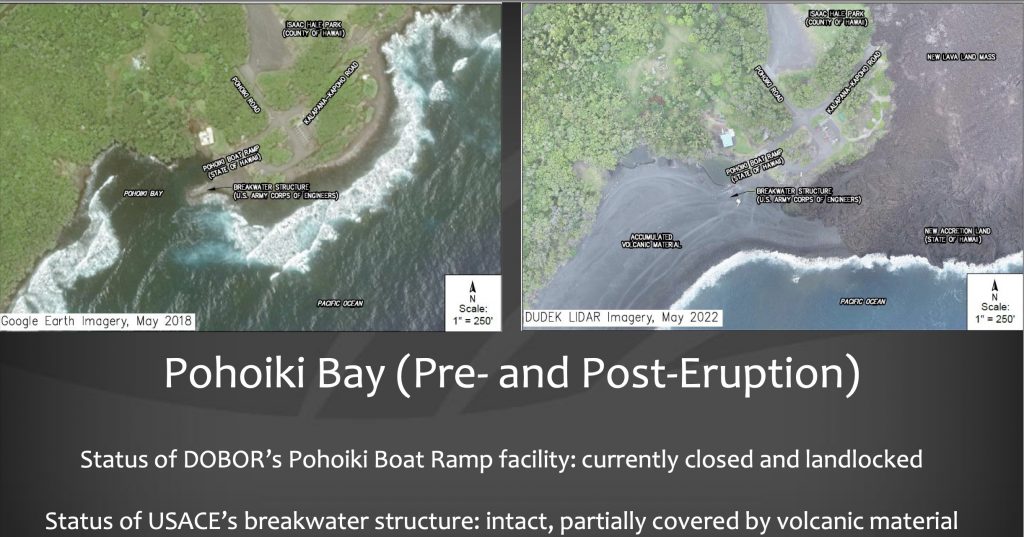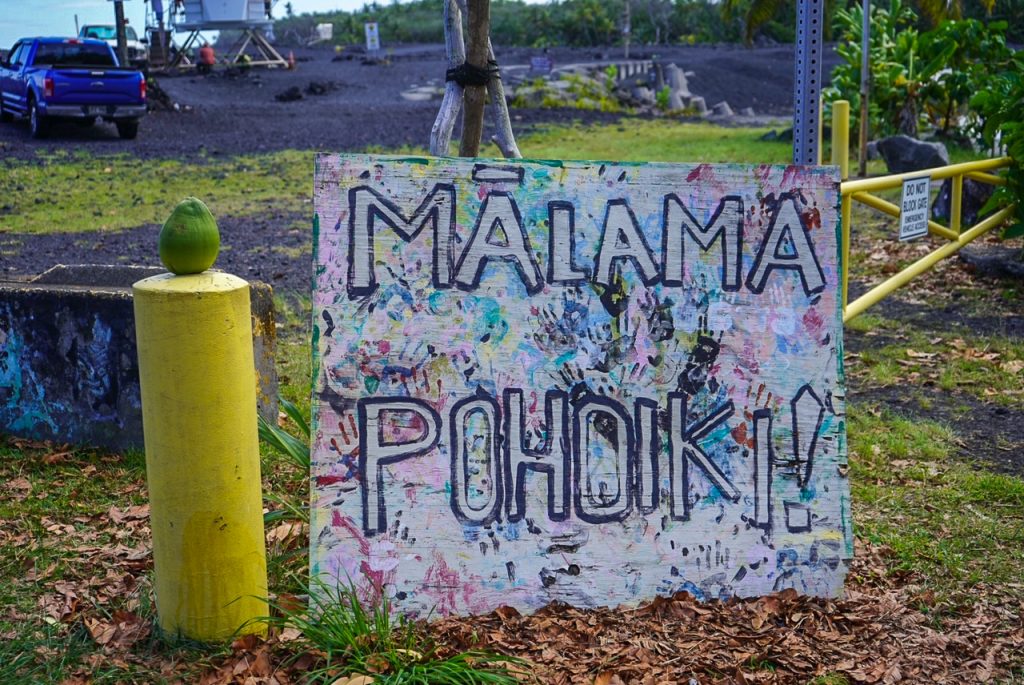5 years after Kīlauea eruption Puna still waiting for restored ocean access, park repairs
The first time Leila Kealoha went to Pohoiki Bay — after the 2018 Kīlauea eruption destroyed homes and roads in Puna during a five-month reign of terror— she cried.
The 46-year-old Puna native used to spend every summer swimming, surfing and fishing at the black sand beach along the bay.
But when she saw the beach and bay five years ago, after they were covered by volcanic debris, boulders and sand, Kealoha knew her children no longer would be able to enjoy it the way she did as a kid.
“It’s a huge beach there, but you can’t swim,” she said. “It’s so rough.”
Part of Hawai‘i County’s eruption recovery plan is repairing damage and upgrading Isaac Kepo‘okalani Hale Beach Park, which is along the bay. In the long-term, county officials hope improve ocean access for swimming at Pohoiki Bay.
The restoration for the beach park and the neighboring park ‘Ahalanui Hot Ponds was estimated by Hawai‘i County to cost $40 million.
Hawai‘i County Councilwoman Ashley Kierkiewicz said only $4.9 million out of the $300 million received in federal and state funds will go toward parks.
The county’s recovery plan does not include restoring ocean access to the Pohoiki boat ramp, which became landlocked due to the eruption. That is a state project, also estimated in 2022 to be $40 million, because the bay is state-owned.
To date, the State of Hawai’i has only appropriated about $5.4 million in state funding to the Department of Land and Natural Resources’ Division of Ocean and Recreation to restore access to the boat ramp.

Pohoiki, a small 1,000-foot bay and once home to the state’s third most productive boat ramp in the state, had been part of a fishing village for centuries.
Jon Olson, Puna resident for 46 years, said when it comes to ocean access in Puna the place to go is Pohoiki Bay.
“You can’t beat it,” Olson said. “It’s like diving in a gin bottle.”
The coastline was lost during the eruption, with the surf line an 8-foot wall of rock, Olson said.
Now, getting in and out of the water requires climbing over loose boulders.
“You have to be skilled water person to get in and out,” he said.

As part of Hawai‘i County’s Revitalize Pohoiki plan released in May 2022, $3.1 million will go toward Isaac Kepo’okalani Hale Beach Park. The plan also includes educating the public about how to act in these culturally important and sacred spots, but it does not include creating swimming access.
Proposed improvements include:
- 32-by-80-foot pavilion with walkway and grassed area
- Native landscaping with help from community volunteers
- 16-by-12-foot Hale Kua‘i (Pavilion)
- 8-foot wide accessible walkway with ramps and picnic tables on concrete pads
- 30-by-60-foot Hale Wa‘a (The house of the canoe)
- Restore electrical system
- Paved parking stalls
Approximately $100,000 will go toward other park improvements, such as resurfacing the tennis courts at Shipman Park in Puna.
The remaining $1.76 million will go toward:
- 2 bucket trucks for tree trimming
- Tracked skid steer to address safety concerns at ball fields
- Rubbish truck for Puna parks
- 2 dump trucks
- 2 flatbed trucks with dump
- 3 heavy-duty trailers to transport equipment
- 3 excavators
- 1 Backhoe to replace existing backhoe that is at the end of its life
- 2 auto scrubbers for indoor courts
Parks and Recreation Director Maurice Messina said his office will work with the Mayor’s Office and Finance Department on additional funding for future park expansion projects.
The eruption also inundated surf spots — Elevators, Secrets, Bowls and Shacks — that were accessed through Pohoiki Bay. They can’t be saved because they are buried under several feet of lava.
“This community is founded on its access to the ocean,” said Amadeo Markoff, Puna business owner and community advocate. “It’s one of the reasons we moved here. Not having the ability to get into the ocean is catastrophic.”

While the Revitalize Pohoiki plan doesn’t include plans to create safe swim areas along with safe boat access, county officials hope to address this with the state within the next three to five years. Specifically, the proposed plan includes using state funds for a safe swim study to design a safe swim area.
County officials plan to establish protocol and community education for accessing safe swim areas.
Lack of access to the bay has also hit families on a financial level. The loss of the ramp “limits the once robust fishing economy as well as access to the recreational coastline areas,” according to the Federal Emergency Management Agency’s draft environmental assessment released on Aug. 3.
Described as Puna’s icebox, fishermen haven’t been able to get out into the ocean for five years, disrupting their livelihoods.
“And we’re hungry,” said Kealoha, who comes from a family of fishermen.
For what it is, Olson said the Pohoiki Revitalize plan does no deliberate harm. He is working with Parks and Recreation to create ocean access at ‘Ahalanui Hot Ponds, just north of Pohoiki Bay. While much of the area was inundated with lava, Olson said the new shoreline allows for an opportunity to create an additional way to get into the water.
Although Olson lost his home in the eruption, he said the lava giveth and it taketh.
Lava flows covered 13.7 square miles of land, but it also created 840 acres of new shoreline.
In this instance, Olson said, the eruption has given more because it created more public shoreline. Before, much of the shoreline in this area had been privately owned.
Hawai’i County Mayor Mitch Roth formed a working group to discuss and plan for more ocean access in Puna. A partnership has since formed between the county and community members called Hui ‘o Ahalanui.
“We are discussing ways to utilize the area where ‘Ahalahui Beach Park once stood, that is now under about 30 feet of lava,” Messina said.
Olson, along with other community members plan to create trails along the new shoreline. Since the newly created land is State of Hawaiʻi property, Messina said any discussion involving its development must involve the state.
Editor’s note: This story is the fourth in a series about recovery efforts from the 2018 Kīlauea Eruption. Next week, we will explore restoration efforts of Pohoiki Boat Ramp. Hawai‘i County posts regular updates about their recovery efforts at recovery.hawaiicounty.gov.
Other related stories to the 2018 Kīlauea eruption:
- 5 Pāhoa residents reflect about 2018 Kīlauea lava flow, its impact — and life now
- Recovery frustratingly slow from 2018 Kīlauea eruption, but continues five years later
- 5 years ago on Big Island: ‘Eruption in Leilani, no joke. Lava is coming out right now.’
- 5 years after Kīlauea eruption created new beach, Pohoiki boat ramp remains landlocked
- 2018 Kīlauea eruption destroyed Hawaiian Volcano Observatory’s home; now its getting a new one in Hilo
- Light at end of tunnel for Puna’s road woes caused by lava from 2018 Kīlauea eruption
Sponsored Content
Comments








